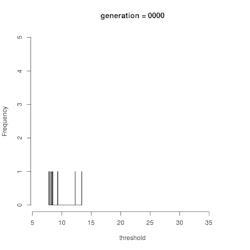/
2017-12-27 --- PoW Style Fork-Choice Rule
2017-12-27 --- PoW Style Fork-Choice Rule
Observations
- Very high PC spending thresholds are no longer favoured.
- For a population of 46 validators with threshold ~10:
- Fraction of blocks which are proposals seems to converge to ~0.4
- It is unclear whether less branching is occurring – more quantitative data needed
- The amount of political capital in the system grows apparently very large – perhaps need to run simulation for more rounds.
Evidence
- Tables and image below show the distribution of validator thresholds as over time. We see the mean and variance both go up then come back down
- See plots below:
Conclusions, Speculations and Future Work
- It looks like ~10 is the optimal value of the threshold (because of the way the population wanders away and then comes back). This would not be a random amount, but in fact equal to the amount on the genesis block. Perhaps we should try changing the amount of PC on the genesis block to see if this pattern holds.
- These observations are presently inconclusive.
- Not sure what the proposal fraction should represent, or what an ideal value might be
- Need to write something which quantifies "branching" and "dead branches" in order to understand the visualization better
- Probably need to run the simulation longer when there are this many validators. This could have an impact on the evolution results since the population grows over the simulation, so either the run length needs to depend on the number of validators or I need to fix the population size. The latter would be much faster computationally, so might be the better option.
Related content
2018-01-02 --- Model of Total PC and Quantifying Branching
2018-01-02 --- Model of Total PC and Quantifying Branching
More like this
2017-12-22 --- ThresholdSpender High Threshold Invasion
2017-12-22 --- ThresholdSpender High Threshold Invasion
More like this
2017-12-21 --- ThresholdSpender Evolution
2017-12-21 --- ThresholdSpender Evolution
More like this
2018-01-08 --- PoW-style fork-choice rule definitively causes less branching than GHOST
2018-01-08 --- PoW-style fork-choice rule definitively causes less branching than GHOST
More like this
2017-12-28 --- Exponential Growth of Political Capital
2017-12-28 --- Exponential Growth of Political Capital
More like this
2018-06-29 Validator Economics Meeting
2018-06-29 Validator Economics Meeting
More like this

